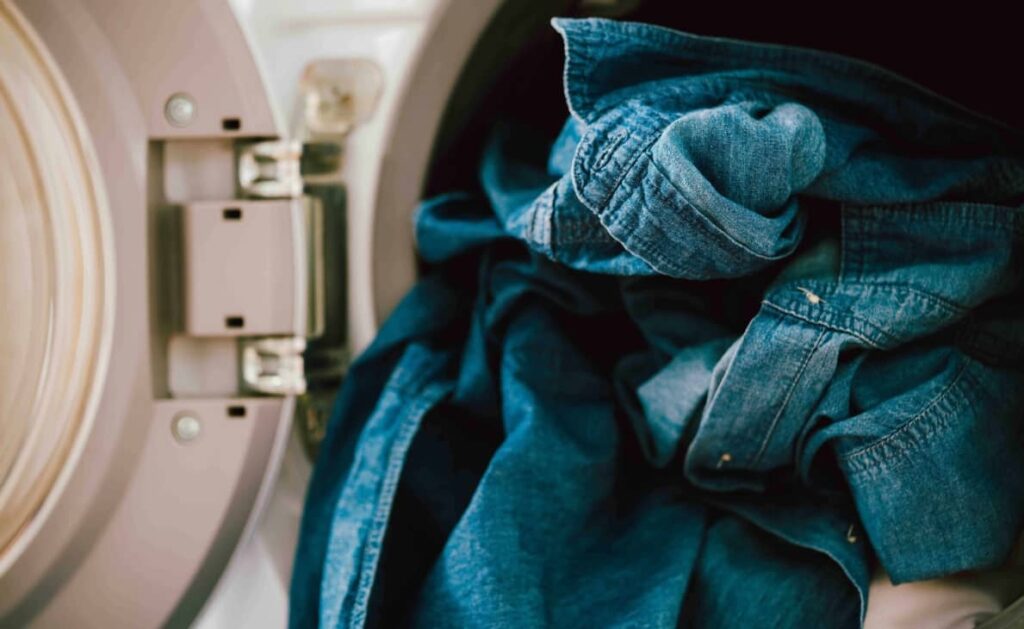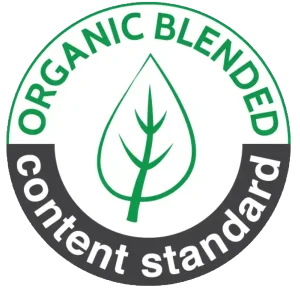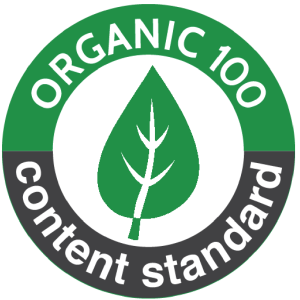In the textile industry, the stone wash process has become an indispensable technique for creating a worn, naturally faded look and a soft feel for denim and cotton products. However, the traditional method using natural pumice stone raises many environmental concerns, from resource extraction to the amount of solid waste and dust generated.
To address these challenges, recycled pumice has emerged as a green trend, offering comparable effectiveness while being more environmentally friendly in the stone wash process.
This article will delve into explaining what recycled pumice is, why it has become a sustainable solution in the stone wash process, its application steps, and the benefits it brings. We will explore how pioneering manufacturers are transitioning to apply this technology, contributing to the sustainable development of the global textile industry and particularly in the professional stone wash process.
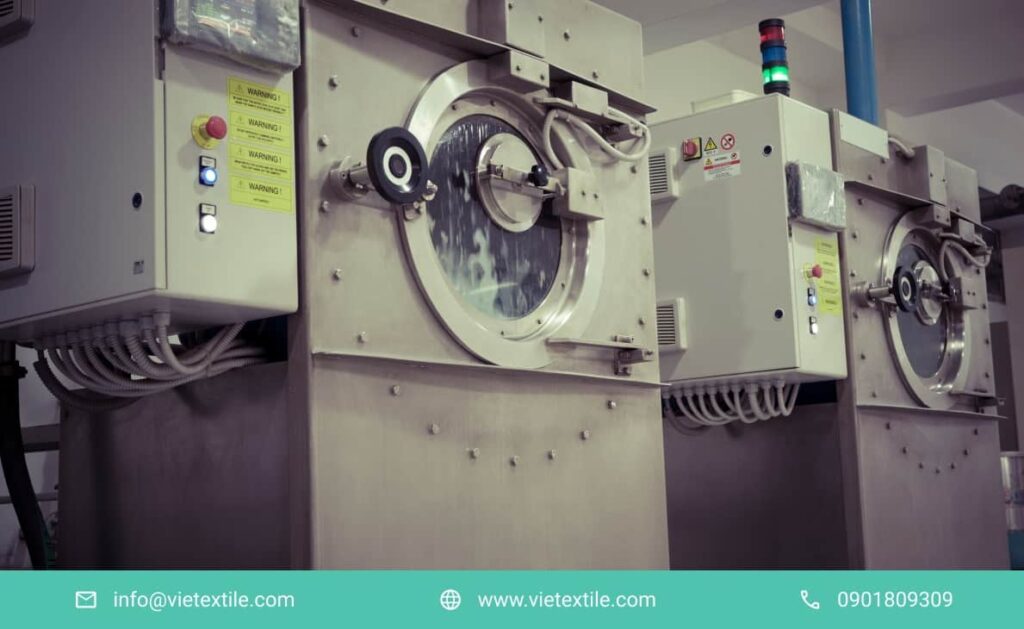
1. What is Recycled Pumice in the Stone Wash Process?
Nội dung tóm tắt
ToggleRecycled pumice is an abrasive material produced from recycling used pumice stone or from other materials with similar abrasive capabilities. Instead of extracting new pumice stone from volcanic quarries, recycled pumice is created through processing and reshaping existing materials, aiming to minimize the environmental impact of the traditional stone wash process.
Unlike naturally extracted pumice stone, recycled pumice typically undergoes a process of crushing, cleaning, and then being pressed or bonded into uniform-sized and shaped stones. Some types of recycled pumice are also produced from synthetic materials or other industrial waste with suitable abrasive properties, specially designed to optimize effectiveness in the stone wash process and reduce dust.
2. Why is Recycled Pumice a Green Trend in the Stone Wash Process?
The use of recycled pumice in the stone wash process offers many superior environmental and economic benefits, making it an inevitable trend in the sustainable textile industry.
2.1. Minimizing Natural Resource Extraction
The traditional stone wash process relies on the extraction of natural pumice stone, which is a finite resource. Quarrying activities cause significant negative environmental impacts such as destruction of natural landscapes, soil erosion, air pollution, and noise. By using recycled pumice, the industry can significantly reduce the demand for new pumice stone extraction, conserving natural resources and minimizing adverse effects on ecosystems. This is an important contribution to the sustainability of the stone wash process.
2.2. Reducing Solid Waste and Dust
Natural pumice stone tends to crumble and wear down quickly during the stone wash process, generating a large amount of stone dust and sludge. Handling this solid waste is a major and costly challenge for factories, and it causes environmental pollution if not properly managed. Recycled pumice, especially more durable engineered types, crumbles less, significantly reducing the amount of dust and sludge generated. This not only eases the burden of waste treatment but also improves the working environment in the factory.
2.3. Saving Energy and Transportation Costs
The extraction and transportation of natural pumice stone from quarries (often distant) to textile factories consume a large amount of energy and generate carbon emissions. Recycled pumice can be produced closer to industrial centers or from local waste sources, significantly reducing transportation distances and fuel consumption. This not only saves logistics costs but also reduces greenhouse gas emissions, contributing to the carbon footprint reduction goals of the stone wash process.
2.4. Ensuring Consistent Quality and Reusability
Recycled pumice, especially engineered types, can be strictly controlled for size, shape, and abrasiveness. This helps achieve a more uniform and controllable wash effect compared to natural pumice stone, which has variable properties. Furthermore, some types of recycled pumice are more durable, allowing for multiple reuses, reducing the cost of purchasing abrasive materials and enhancing the economic efficiency of the stone wash process.
2.5. Meeting Sustainability Demands from Brands
In a context where consumers and international fashion brands are increasingly concerned about supply chain sustainability, adopting recycled pumice in the stone wash process is a way for manufacturers to demonstrate their commitment to the environment. This helps businesses meet green production requirements, enhances brand image, and expands cooperation opportunities with large partners who prioritize socially and environmentally responsible suppliers.
3. Process for Applying Recycled Pumice in Professional Stone Wash Process
Applying recycled pumice in the professional stone wash process requires adjustment and strict control to achieve optimal effectiveness and ensure sustainability.
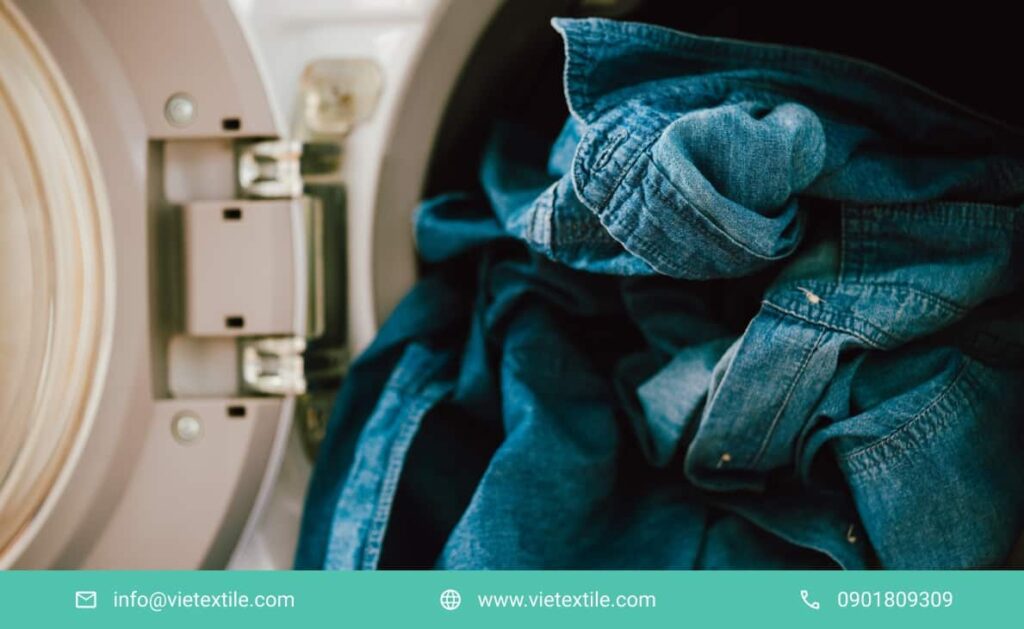
3.1. Recycled Pumice Preparation and Classification
Before use, recycled pumice needs to be thoroughly inspected and classified.
3.1.1. Stone Quality Inspection
Recycled pumice needs to be inspected for hardness, abrasiveness, size, and uniformity. This ensures that the stone will produce the desired wash effect without damaging the fabric or machinery. Reputable recycled pumice suppliers typically have strict quality control processes to ensure products meet standards for the stone wash process.
3.1.2. Classification by Size and Abrasion Level
Recycled pumice is classified by size (large, small, mixed) and abrasiveness (high, low) to suit different fabric types and wash effects. For example, larger stones will create a more distinct distressed effect, while smaller stones create a more subtle faded effect. Precise classification helps optimize results in the stone wash process.
3.2. Fabric Pre-treatment
Similar to the traditional stone wash process, fabric (typically denim or cotton) needs to be thoroughly pre-treated to remove impurities and prepare the surface for abrasion.
3.2.1. Pre-Wash
Raw jeans or denim fabric needs to be pre-washed to remove sizing, oils, and other impurities. This helps ensure a uniform fabric surface, allowing recycled pumice to abrade effectively and create a consistent wash effect. Pre-washing is fundamental for any quality stone wash process.
3.2.2. Fabric Softening (Optional)
In some cases, fabric may be pre-softened to reduce initial stiffness, allowing recycled pumice to abrade more easily and reducing the risk of fabric becoming brittle or tearing during abrasion. However, this needs to be considered to avoid reducing the stiffness necessary for the effect.
3.3. Abrasion Process
This is the core stage of the stone wash process, where recycled pumice performs its function.
3.3.1. Loading Fabric and Stones into Washing Machine
Fabric and recycled pumice are loaded into a specialized industrial washing machine at an appropriate ratio. The stone-to-fabric ratio will directly affect the abrasion intensity. Water quantity, temperature, and auxiliary chemicals (such as enzymes, wetting agents) are also added to create an optimal environment for the abrasion process.
3.3.2. Tumbling and Abrasion
The washing machine will tumble at a specific speed and intensity, causing recycled pumice and fabric to continuously abrade each other. Tumbling time is a key factor, determining the degree of fading and distressing. Longer tumbling time results in a more pronounced stone wash effect. This process needs to be continuously monitored to achieve the desired effect without excessively damaging the fabric.
3.3.3. Using Auxiliary Chemicals (Optional)
In some cases, auxiliary chemicals such as cellulase enzymes can be added during this stage to enhance softening and subtle fading effects, or bleaching agents (e.g., ozone) to achieve stronger fading effects. This needs to be strictly controlled to ensure the safety of fabric fibers and color.
3.4. Post-Abrasion Treatment
After the abrasion stage, fabric needs to be treated to remove dust and finish the surface.
3.4.1. Removing Dust and Stone Residue
This is an extremely important step. Fabric will be thoroughly shaken to remove dust; air blowers or specialized vacuum cleaners may be used to completely remove any recycled pumice particles clinging to the fabric surface or inside pockets. This prevents stone dust from irritating the skin and damaging washing machines in subsequent stages.
3.4.2. Thorough Washing and Neutralization
The product will be thoroughly washed in an industrial washing machine to completely remove dust, chemical residues (if any auxiliary chemicals were used), and any remaining small abrasive particles. If bleaching chemicals were used, a neutralization step is required to completely remove chemical residues, ensuring fabric durability and safety.
3.5. Product Finishing
This final stage ensures the product meets the highest standards.
3.5.1. Fabric Softening
After abrasion, the fabric may feel slightly rough. Fabric softener will be applied to restore softness, providing a pleasant hand-feel.
3.5.2. Drying and Setting
Fabric is dried in industrial dryers at controlled temperatures and may be set (stentered) to maintain its standard shape and remove wrinkles.
3.5.3. Quality Inspection
The final product is thoroughly inspected for abrasion effect, fading, distressing (if any), fabric durability, and any defects. This ensures each product meets the highest standards before delivery to the customer.
4. Challenges and Solutions When Using Recycled Pumice in the Stone Wash Process
Although recycled pumice offers many benefits, applying it in the stone wash process also comes with some challenges that need to be addressed.
4.1. Challenge of Recycled Pumice Quality Consistency
Challenge: The quality of recycled pumice may be inconsistent if the production process is not strictly controlled, leading to inconsistent wash effects or fabric damage. Solution: Choose reputable recycled pumice suppliers with strict quality control processes. Perform regular incoming stone quality inspections to ensure uniformity in hardness, size, and abrasive capability for the stone wash process.
4.2. Challenge of Initial Investment Cost
Challenge: Investing in recycled pumice production technology or purchasing high-quality recycled pumice can require a certain initial cost. Solution: Consider the long-term benefits of resource savings, reduced waste treatment costs, and enhanced brand image. Seek support programs or incentives from the government for green projects.
4.3. Challenge of Compatibility with Existing Machinery
Challenge: Some types of recycled pumice may have different properties compared to natural pumice stone, requiring adjustment of washing machine parameters or even upgrading some components to optimize effectiveness. Solution: Collaborate with stone wash process experts to assess machine compatibility and receive advice on necessary adjustments.
4.4. Challenge of Market Acceptance
Challenge: Some brands or consumers may be unfamiliar with or skeptical about the effectiveness and aesthetic appeal of products processed with recycled pumice. Solution: Clearly communicate the environmental benefits and quality of the stone wash process using recycled pumice. Provide high-quality product samples to demonstrate effectiveness.
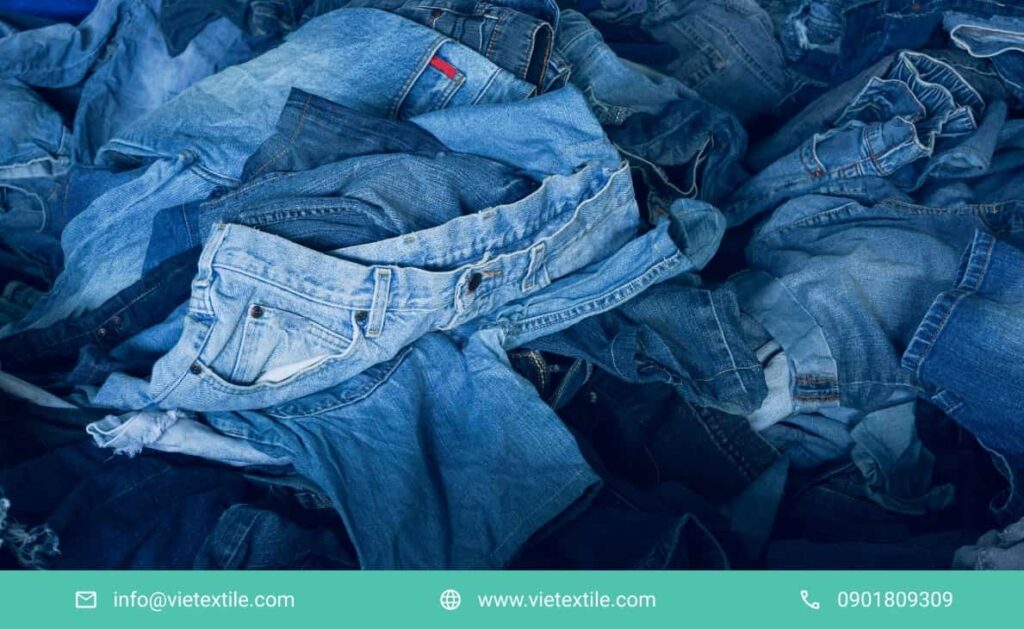
5. VieTextile: Pioneer in Sustainable Stone Wash Process with Recycled Pumice
VieTextile proudly stands as one of the pioneers in applying the sustainable stone wash process in Vietnam, particularly focusing on the use of recycled pumice. We understand that creating unique fashion products should not come at the expense of the environment.
With investment in modern wash technology, strict quality control processes, and a team of experienced engineers and specialists, VieTextile commits to:
- Creating natural and unique stone wash effects: Ensuring products achieve the desired look with high durability and quality.
- Applying high-quality recycled pumice: Using certified recycled pumice, optimizing abrasion effectiveness and minimizing environmental impact.
- Environmentally friendly process: Significantly reducing water, chemical, and solid waste, contributing to sustainable production.
- Customized solutions: Advising and developing wash formulas suitable for each fabric type and design requirement, adding value to your products.
Let VieTextile accompany you, transforming your most stringent requirements for style and sustainability into reality in the professional stone wash process.
6. Frequently Asked Questions
To help our valued customers better understand the stone wash process using recycled pumice, here are some frequently asked questions:
6.1. Can recycled pumice create stone wash effects similar to natural pumice stone?
A: Yes, modern recycled pumice types are designed to simulate and even improve the abrasive effectiveness of natural pumice stone. They can create similar distressing, fading, and mottled effects, with better control over uniformity.
6.2. Does using recycled pumice increase costs for the stone wash process?
A: While the cost of purchasing high-quality recycled pumice may differ from traditional pumice stone, in the long run, it helps reduce operating costs (less dust, less sludge, reusability) and enhances the brand’s sustainable image, providing overall economic benefits for the stone wash process.
6.3. How does VieTextile ensure the sustainability of recycled pumice in the stone wash process?
A: VieTextile collaborates with reputable recycled pumice suppliers who are certified for sustainable production processes. We also continuously research and test to optimize stone usage, minimize waste, and ensure environmental effectiveness in our stone wash process.
6.4. Besides recycled pumice, what other green technologies does VieTextile apply in the stone wash process?
A: Yes, in addition to using recycled pumice, VieTextile also applies other green technologies such as enzyme wash (softening fabric, subtle fading), ozone wash (reducing water and bleaching chemicals), and laser (creating abrasion effects without water/chemicals), contributing to a comprehensive and sustainable stone wash process.
7. Contact Information
Contact VieTextile now for consultation on choosing suitable equipment for your stone wash process!
- Hotline: 0901 809 309
- Email: info@vietextile.com
- Website: https://vietextile.com

